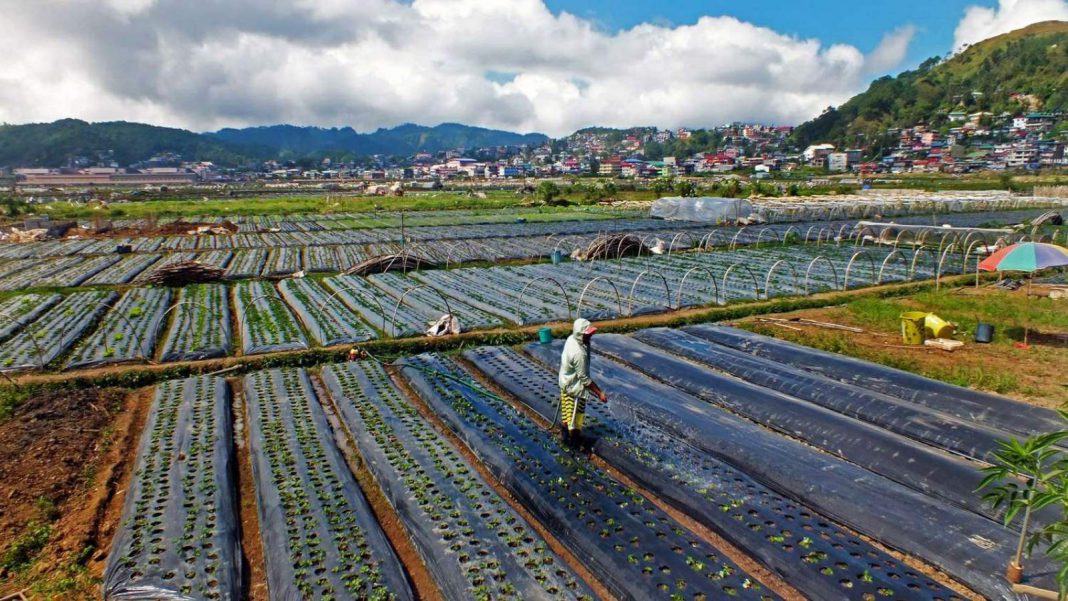In photo: Farmers in Cordillera Region continue to protect their crops and adopt all available technology to help stabilize food supply (Photo from THEPHILBIZNEWS/Mau Victa)
These lofty ideals power the formation of the Department of Science and Technology’s (DOST) Niche Centers in the Region for R&D (NICER). In an online symposium held last Tuesday, October 19, 2021, the NICERs focusing on food security such as inland marine and aquatic resources, together with crop and livestock presented their latest breakthroughs to contribute to the achievement of zero hunger in the country.
Under the umbrella of the DOST-Science for Change Program, NICERs capacitate regional higher educational institutions’ ability to conduct quality research and boost regional economic growth.
“We need to capacitate our regions to be ready for the challenges of the new environment,” said DOST Secretary Fortunato T. dela Peña. “Food security and safety are two sectors that propel our nation forward. We must invest in R&D to end hunger and strengthen our food systems and sustain activities that support regional development.”
“The establishment of these NICERs are among the key strategies towards developing a more STI-driven, sustainable, resilient, and progressive countryside – stimulating the industry sector and contributing towards achieving zero hunger in the near future,” said Undersecretary for Regional Operations Sancho A. Mabborang.
The first center presented was under the Inland Aquatic industry. The Isabela State University (ISU) in Cagayan Valley Region hosts the Freshwater Fisheries R&D Center. This NICER has successfully increased the average weight of glass eels or igat by 204% and their average survival rate from 70% to 94%, established rearing facilities in eleven (11) municipalities to grow ludong or Lobed-River Mullet, generated employment for the Indigenous People, and established the Cagayan Valley Aquaculture Producers Cooperative which encouraged the community to venture into eel and freshwater fish production.
The second center presented was under the Marine Resources industry. The Mindanao State University-Naawan (MSU-Naawan) in Northern Mindanao hosts the Sea Cucumber R&D Center. The Center focuses on 2 species of sea cucumbers, the white teatfish, Holothuria fuscogilva, and sandfish, Holothuria scabra. The white teatfish is still in its experimental stages of developing its spawning and larval rearing protocols, and the sandfish is up and running for its production and promotion for farming among community beneficiaries as their source of alternative livelihood.
This NICER has recorded 58 commercial sea cucumber species across stations in Mindanao, and found that sea cucumber fisheries in sampling sites in Mindanao are generally small-scale involving 700 households with varying gathering methods depending on location and depth.
The third center presented was under the Crops industry. The Pampanga State Agricultural University (PSAU) in Central Luzon hosts the Tamarind R&D Center. In 2 years’ time, this NICER has increased the areas in Central Luzon planted with tamarind from 187 to 271.5 hectares.
Lastly, under the Livestock industry. The Marinduque State College (MSC) in MIMAROPA hosts the Markaduke R&D Center. This NICER has achieved improvement in the number of piglets weaned from 13 to as high as 18 pigs weaned per sow per year (PWSY). More genetic improvements are soon to be achieved having found favorable genes for litter size (Estrogen Receptor 1: 17% to 36%), growth (Myogenin: 14%), meat quality (Leptin: 86%), and disease resistance (Fucosyltransferase 1: 22% to 50%). Its artificial insemination laboratory is equipped with state-of-the-art computer assisted sperm analyzer to improve the reproductive efficiency of the male breeding pig (boar). The technology on feeding and husbandry practices are in line with the low-cost, low-input production system to be adaptable and practical under the house-hold farming condition.
With all these achievements, DOST pushes to sustain their efforts in the Science for Change Program by lobbying for the passage of the Science for Change Program (S4CP) Bill which seeks to address the disparity in research and development (R&D) funding in the Regions and lack of R&D in the private sector. Once approved, the S4CP Bill will promote inclusive, equitable, and sustainable development through the optimal use of the R&D budget equitably and systematically in all regions in the country. The S4CP bill also aims to achieve self-reliance in various sectors including the food sector, manufacturing sector and health sector, among others.
“The NICER program introduced R&D interventions to enhance agricultural yields in the Regions to spur economic growth and contribute to food security,” said Undersecretary for R&D Rowena Cristina L. Guevara. “DOST intends that these NICERs will produce and attract the leading experts in high-impact sectors in support of the creation of regional hubs for the technology transfer and commercialization of R&D outputs.”














